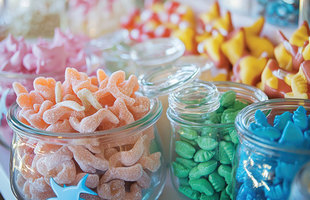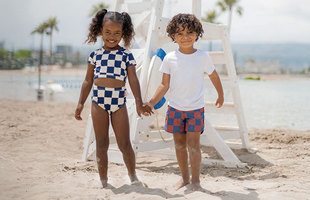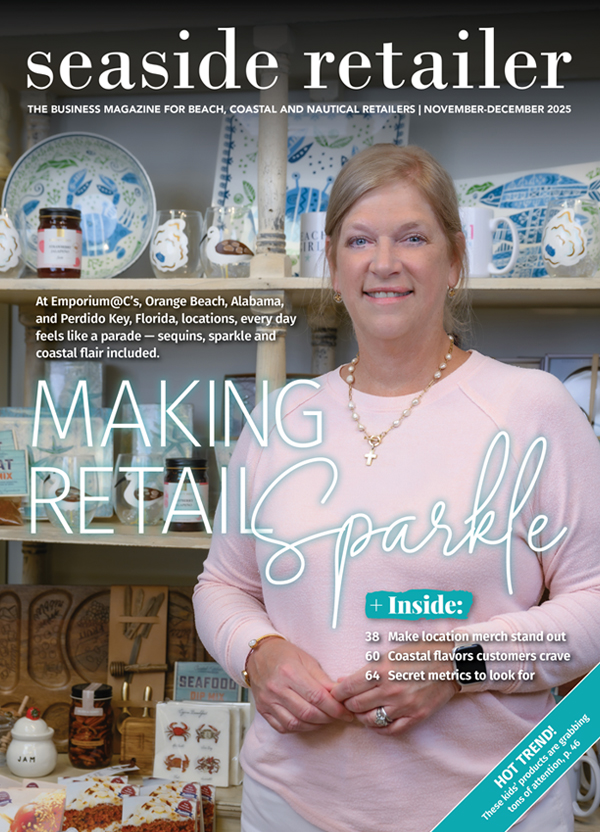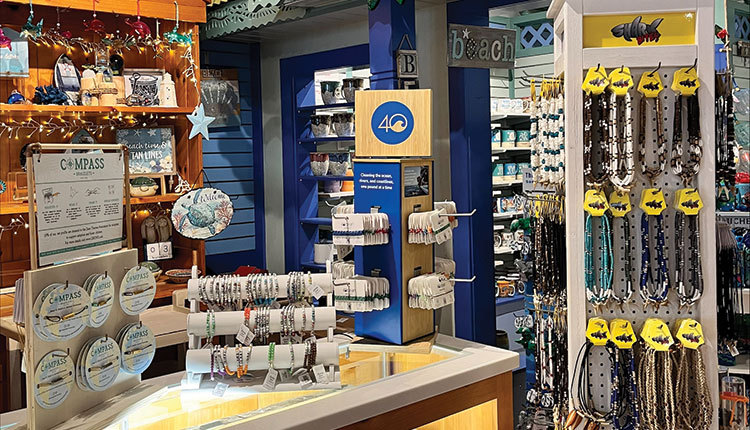
Gaudy or dainty, silver or gold, bright or muted, modern or retro. Whether a family heirloom or a rare find, the jewelry one chooses to wear typically makes a statement about him or her. And when it comes from an aquarium gift shop, the sentiment most heard is that the buyer supports sustainability and the environment.
At The National Aquarium Gift Shop in Baltimore, about 9% of sales come from jewelry and that’s not by accident. Store Director Ashley Macindoe attributes the interest to the causes behind the jewelry and the attention her employees pay to emphasizing those efforts.
“A lot of my team knows that the product knowledge of a piece is very important to getting that sale because the guest is spending a lot of money coming in through the aquarium and buying the ticket,” she says.
“They’re paying for parking, they’re going to pay for their meals. So, you know, they’re already putting out so much money.”
So going the extra mile to buy jewelry from an aquarium gift shop better have meaning behind it. And at the National Aquarium in Baltimore, it does.
For instance, Scout Curated Wears donates 10% of its net profits to causes that support women. Clear Seas bracelets remove a pound of trash from the ocean every time that a customer buys one. Live Love Protect bracelets contribute proceeds to helping wildlife. Pura Vida bracelets donate 5% of the purchase price to the Surfrider Foundation “to protect the world’s oceans, waves and beaches,” according to the bracelet’s literature. 1 Tree Mission is “committed to reforesting our earth by planting one tree for each bracelet purchased,” according to the company’s website.
“Gift shops are a little pricier than your regular store, so there has to be that added layer of, ‘Hey, we’re actually doing things for the environment,’” she points out. “It’s important for us to note that your money is going to a good cause. You’re not just buying a bracelet.”
To draw attention to such causes, Macindoe says, the store features a TV monitor over 1 Tree Mission’s merchandise that shows a looping segment of the trees planted for every purchase.
But nothing draws the eye more than the gift shop’s 12-foot wall where the jewelry is grouped by brand and the causes they support.
“We used to have spinners, but we found that they would get really crowded, especially as we came back from COVID and we started getting busier again,” she explains. “So we took [the jewelry] off all of the spinners and we put it onto the wall. And then we also have a smaller spinner for the stuff on a shelf.”
Macindoe notes that most of the store’s jewelry offerings are geared toward teenagers; among the most popular — the classic mood rings and best friend (BF) necklaces. She attributes the attraction to the price points at less than $20, with merchandise ranging from $9 to $20. Displays are located near the registers so staff can keep an eye on them.
“We experience shrink, that’s for sure,” Macindoe admits. “No one’s coming to an aquarium to steal, so it’s definitely a crime of opportunity.”
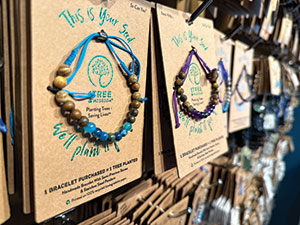
Macindoe teaches the team that guest service is the No. 1 combat against shoplifting. The displays used to be in the front next to the exit, “and we were finding that a lot was going on there. But since we’ve moved it and it’s now next to the register, sure, we still find empty packages around sometimes but not nearly as much. And it’s really just about that guest service.”
Macindoe notes that jewelry sales are about the fifth-highest selling category for merchandise at the National Aquarium.
“For us to really capture that sale, we can’t just rely on them wanting a necklace,” she says. “Really, it’s the effort that there’s an added layer of ‘you’re doing good with your purchase.’”
A strong message
She notes that the shop carries both youth and adult jewelry at a wide range of price points that account for 7% to 9% of the store’s overall sales, with youth fashion jewelry being the most popular selection.
“Pura Vida is a very popular brand across all demographics and with the addition of a conservation message and mission, it draws a connection between the guest and a give-back initiative,” she explains.
And while the majority of Oregon Coast Aquarium jewelry assortment is designed to reflect the animals at the aquarium, it also showcases pieces that are inspired by the oceans as well as options that have been chosen for their planet and other animal-conservation missions.
“The Oregon Coast Aquarium is home to almost 400 different species, but there are specific animals that we call ‘Ambassador Animals.’ These are the ones that aren’t generally on view but are featured in educational presentations and demonstrations at the aquarium,” she notes. “We make sure to feature these species in the jewelry assortment, so you’ll see jewelry that represents Wilson, our resident barn owl, as well as Duff and Link, our western pond turtles.”
No incentive needed
Sometimes selling jewelry doesn’t take much effort at all — customers will buy it. Take for example, Jenkinson’s Aquarium located on the boardwalk in Point Pleasant Beach, New Jersey.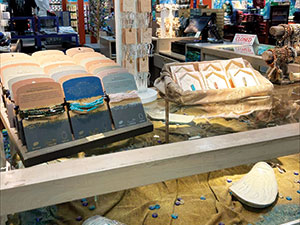
“I don’t have to advertise my jewelry, honestly, I don’t. It’s just sells itself,” insists Cathy Brand, the buyer for the gift shop attached to the aquarium. “They come in here, they go right to it.”
She adds that only plush outsells the jewelry, which accounts for 30% of the sales in the 2,000-square-foot shop that is also filled with books, toys, home decor, beach goods, signs, coffee mugs, apparel, magnets, keychains, stickers and lanyards, among other novelties.
“We sell a lot of shark jewelry, a lot of bracelets,” Brand notes. “Anklets are our No. 1 seller as far as jewelry goes. They love anklets. And I try to keep in the store as much sea life-type of jewelry as possible.”
Items with turtles, seahorses, starfish and sand dollars as well as freshwater pearl necklaces and bracelets seem to fly off the shelves in what is believed to be the largest souvenir shop on the boardwalk. “But overall, we sell it all,” Brand stresses. “It all goes.”
Like the National Aquarium, among the most popular product lines are those with a cause to support. For instance, 4Ocean is “an ocean cleanup company dedicated to ending the ocean plastic crisis,” according to the company’s website.
“They go in the ocean and they clean up all the plastic and garbage and they make bracelets out of it,” Brand explains.
Meanwhile, Fahlo bracelets come with a real wild animal to track and partners with nonprofit organizations to support wildlife conservation, according to its website.
With displays on the wall, on pegboards, racks, spinners and tabletops, Brand says the intent is to keep the jewelry “front and center.”
And the strategy pays off, as Brand says women tend to go for bracelets and necklaces while the younger kids go for bracelets and anklets.
“We’re on a boardwalk. We’re sitting on the Atlantic Ocean, so people are coming here to the seashore, so I try to cater to that,” Brand notes. “They’re getting a starfish from the boardwalk. They’re getting a bracelet that says Point Pleasant Beach on it, or Jenkinson’s so I try to make it conducive to where they’re vacationing.”
Giving jewelry sales a boost
In another destination known for its affinity for the ocean and dedication to climate change, the Aquarium of the Bay Gift Shop in San Francisco spreads its message for sustainability with its “green” products, which is why the 4Ocean bracelets reign supreme there as well, according to Jojuan Corbin, retail manager for the gift shop.
Another item Corbin points out that goes hand-in-hand with its jewelry are enamel jewelry boxes from Kubla Crafts. Sea turtles, seahorses, flip flops, butterflies, hummingbirds and mermaids are among the graphics that are air-brushed on the boxes which are made from Capiz, “farm-raised window pane oyster shell,” according to the company’s website.
Corbin adds that while the gift shop tries to match the jewelry to the animals on exhibit, it’s not the most important detail when it comes to sales.
“Lighting is the best friend of jewelry displays,” he asserts. “As long as the lighting is good, then everything works out. There will be times where there will be a good product, but if it’s not under good lights where it will pop up to somebody, then nobody will pay attention to it unless they really get close to it or somebody else touches it.”
In New Jersey, Brand says, good displays are in the amount of research one does. “You gotta follow the trends,” she says, adding that she checks for trends on TikTok, Facebook and Instagram.
At the National Aquarium, Macindoe credits the efforts of her sales team for the store’s success in jewelry displays.
“Keep it full. Have one person or two people, depending on the size of your business, that are just dedicated to every time they come in, they check the jewelry, they know what the back stock looks like,” she recommends.
And in Oregon, Dimicelli notes it’s important to continue the conservation even after guests leave, which is what a bracelet made from reclaimed plastic or a turtle necklace represents — visitors each playing a part in supporting a cause.
“The education doesn’t need to stop at the doors to your store. Using signage to share why your product is special, how it gives back to the environment or how your purchase supports your institution has become a key factor for us,” she says. “More and more, visitors buy what they believe in and since we’re ultimately here to support the aquarium, it’s really important that guests understand how they can play a part.”

